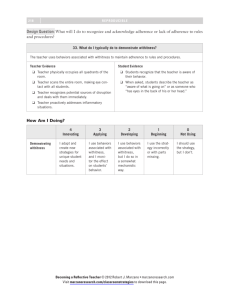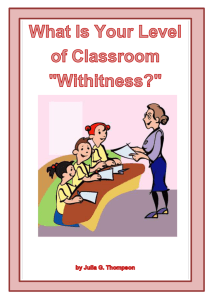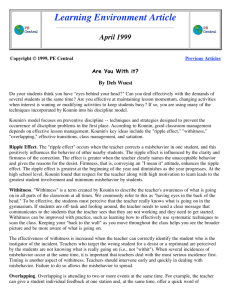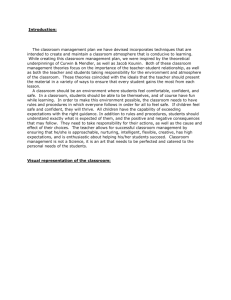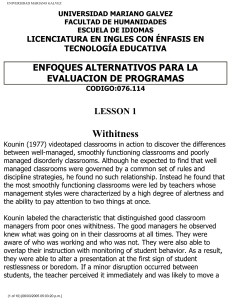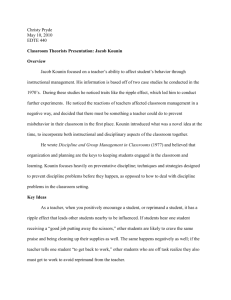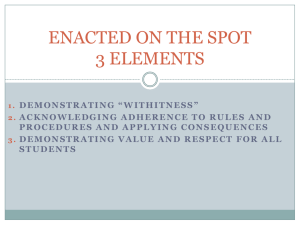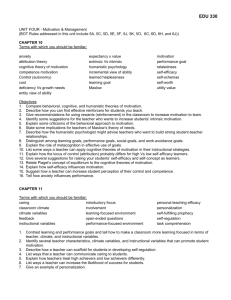Indicator: All teachers travel to all areas in which students
advertisement
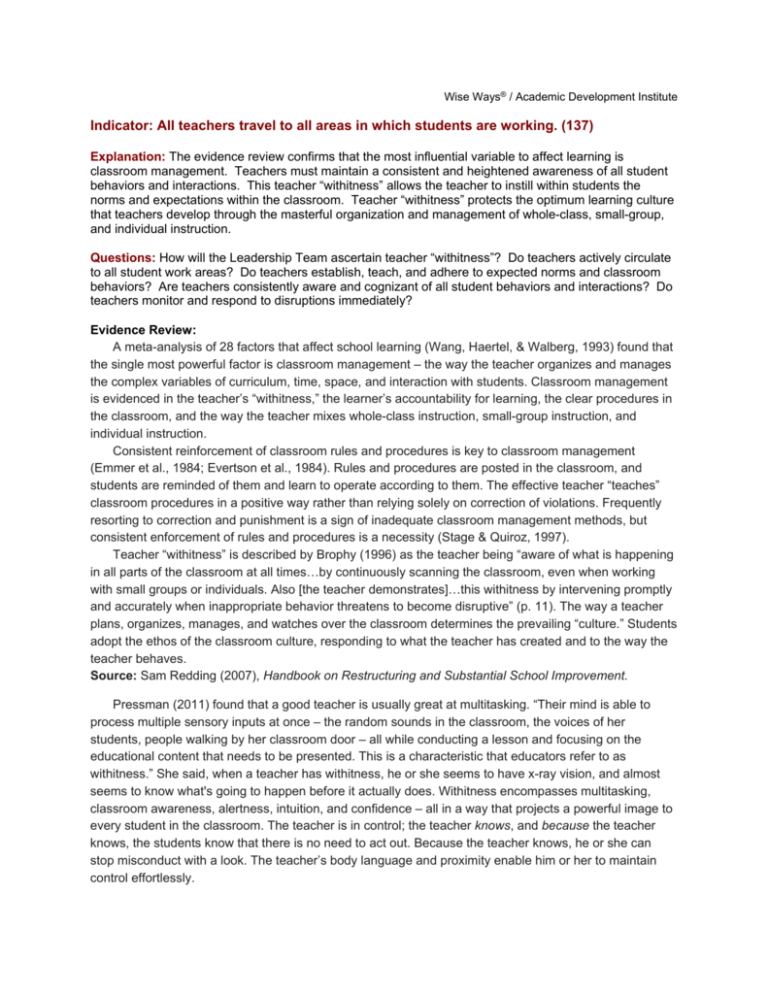
Wise Ways® / Academic Development Institute Indicator: All teachers travel to all areas in which students are working. (137) Explanation: The evidence review confirms that the most influential variable to affect learning is classroom management. Teachers must maintain a consistent and heightened awareness of all student behaviors and interactions. This teacher “withitness” allows the teacher to instill within students the norms and expectations within the classroom. Teacher “withitness” protects the optimum learning culture that teachers develop through the masterful organization and management of whole-class, small-group, and individual instruction. Questions: How will the Leadership Team ascertain teacher “withitness”? Do teachers actively circulate to all student work areas? Do teachers establish, teach, and adhere to expected norms and classroom behaviors? Are teachers consistently aware and cognizant of all student behaviors and interactions? Do teachers monitor and respond to disruptions immediately? Evidence Review: A meta-analysis of 28 factors that affect school learning (Wang, Haertel, & Walberg, 1993) found that the single most powerful factor is classroom management – the way the teacher organizes and manages the complex variables of curriculum, time, space, and interaction with students. Classroom management is evidenced in the teacher’s “withitness,” the learner’s accountability for learning, the clear procedures in the classroom, and the way the teacher mixes whole-class instruction, small-group instruction, and individual instruction. Consistent reinforcement of classroom rules and procedures is key to classroom management (Emmer et al., 1984; Evertson et al., 1984). Rules and procedures are posted in the classroom, and students are reminded of them and learn to operate according to them. The effective teacher “teaches” classroom procedures in a positive way rather than relying solely on correction of violations. Frequently resorting to correction and punishment is a sign of inadequate classroom management methods, but consistent enforcement of rules and procedures is a necessity (Stage & Quiroz, 1997). Teacher “withitness” is described by Brophy (1996) as the teacher being “aware of what is happening in all parts of the classroom at all times…by continuously scanning the classroom, even when working with small groups or individuals. Also [the teacher demonstrates]…this withitness by intervening promptly and accurately when inappropriate behavior threatens to become disruptive” (p. 11). The way a teacher plans, organizes, manages, and watches over the classroom determines the prevailing “culture.” Students adopt the ethos of the classroom culture, responding to what the teacher has created and to the way the teacher behaves. Source: Sam Redding (2007), Handbook on Restructuring and Substantial School Improvement. Pressman (2011) found that a good teacher is usually great at multitasking. “Their mind is able to process multiple sensory inputs at once – the random sounds in the classroom, the voices of her students, people walking by her classroom door – all while conducting a lesson and focusing on the educational content that needs to be presented. This is a characteristic that educators refer to as withitness.” She said, when a teacher has withitness, he or she seems to have x-ray vision, and almost seems to know what's going to happen before it actually does. Withitness encompasses multitasking, classroom awareness, alertness, intuition, and confidence – all in a way that projects a powerful image to every student in the classroom. The teacher is in control; the teacher knows, and because the teacher knows, the students know that there is no need to act out. Because the teacher knows, he or she can stop misconduct with a look. The teacher’s body language and proximity enable him or her to maintain control effortlessly. Wuest (1999) asked teachers if students thought they had eyes in the back of their head, if they can deal with the demands of several students at the same time, and if they are effective at maintaining lesson momentum, changing activities when interest is waning or modifying activities to keep students busy. "If so, you are using many of the techniques incorporated by Kounin into his discipline model." Kounin is an educational theorist who focused on a teacher’s ability to affect student behavior through instructional management. Withitness was Kounin’s word to describe a teacher’s ability to know what was going on at all times in his/her classroom. This can be as simple as making scanning looks around the room every once in awhile. Kounin said that is was not necessary for the teacher to know what is going on, but for the students to perceive that the teacher knows. Kounin (1970) found that a teacher could minimize misbehavior by: Keeping constantly alert to sights and sounds around the classroom. Arranging students to be within sight at all times. Scanning the classroom whenever attending to an individual or small group of students. At the first detection of misbehavior, using a brief acknowledgment to let the class know that you are aware of the misbehavior. Attending to two events at the same time whenever necessary so as not to leave students waiting. When instructing one group, acknowledging difficulties that students outside the group may be having, but keeping group instruction moving. Preplanning the lesson so that extraneous matters are taken care of beforehand. Once students are absorbed in their work, not distracting them, leaving them alone to work and assisting them individually. Keeping the lesson moving briskly. Not overdwelling on a minor or already understood part of the lesson. Correcting students quickly without nagging and return to the lesson. Having students move from one activity to the next without having to wait for each other on each subpart of the transition. Calling on students at random. Raising group interest by interspersing suspense between questions (by saying things like: “This is a tough one coming up.” “Can you figure this one out?” “You haven’t heard of this before.” “I want you all to think hard before responding.”) Having the entire group or class respond in unison. Physically moving around the room and asking students to show what they have done. While asking one student to respond, looking at other students. These skills are particularly applicable today. In their article Can “Withitness Skills” be Applied to Teaching with Laptops?, McDaniel, Jackson, Gaudet, and Shim (2009) presented examples of new problems that laptops and the Internet have created in the classroom. These include sending and receiving e-mail messages, Internet surfing, playing games, watching Internet TV, and being able to see what other students have opened up on their computers. In a section on Withitness, they found, "With laptops and lessons that make use of available technology, the instructor may find that teaching in the back of the room is more effective than in the front. The instructor in the back of the room can observe what students have opened on their computers. It is important for instructors to work on the perimeter of the room exposing their back to as few students as possible or for the shortest period of time. Enforcement of rules, including Internet and laptop use, should be consistent. Instructors must be highly organized to maintain students' interest" (p. 82). McDaniel et al. (2009) conclude their paper, "It may amaze those in education that in this age of technology and computers, how basic concepts of classroom teaching are similar or even more important than they were 40 years ago when Kounin first defined the elements of withitness. New challenges, related to laptop Internet instruction, require instructors to develop 'withitness' skills and situational awareness as they compete with computers for students' attention or participation" (p. 84). References and Resources Brophy, J. E. (1996). Teaching problem students. New York: Guilford. Emmer, E. T., Evertson, C. M., Sanford, J. P., Clements, B. S., & Worsham, M. E. (1984). Classroom management for secondary teachers. Englewood Cliffs, NJ: Prentice-Hall. Evertson, C. M., Emmer, E. T., Clements, B. S., Sanford, J. P., & Worsham, M. E. (1984). Classroom management for elementary teachers. Englewood Cliffs, NJ: Prentice-Hall. Kounin, J. S. (1970). Discipline and group management in classrooms. New York, NY: Holt, Reinhardt and Winston. McDaniel, L., Jackson, A., Gaudet, L., & Shim, A. (2009). Can “Withitness Skills” be Applied to Teaching with Laptops? American Journal of Business Education, 2(4), 81–85. Pressman, B. (2011). Withitness in the classroom. Retrieved from http://www.education.com/reference/article/using-xray-vision-substitute-teacher/ Redding, S. (2007). Systems for improving teaching and learning. In H. J. Walberg (Ed.), Handbook on restructuring and substantial school improvement (pp. 99–112). Lincoln, IL: Center on Innovation & Improvement. Stage, S. A., & Quiroz, D. R. (1997). A meta-analysis of interventions to decrease disruptive classroom behavior in public education settings. School Psychology Review, 26(3), 333–368. Wang, M. C., Haertel, G. D., & Walberg, H. J. (1993). Toward a knowledge base for school learning. Review of Educational Research, 63, 249–294. Wuest, D. (1999). Are you with it? Learning environment article. Blacksburg, VA. Retrieved from http://www.pecentral.org/climate/april99article.html ©2014 Academic Development Institute
